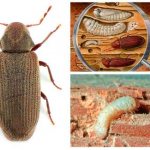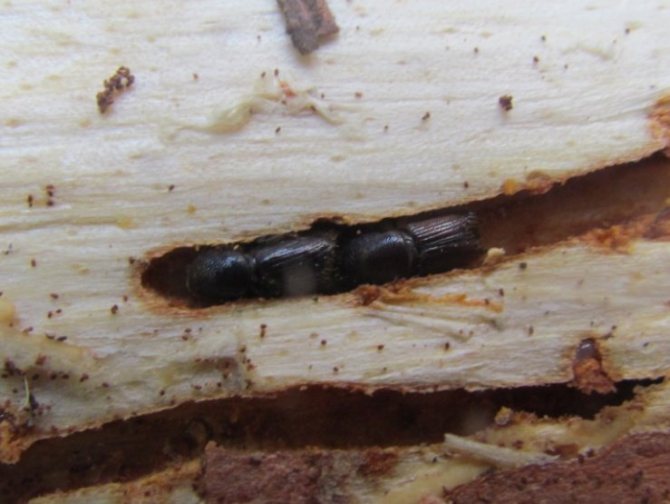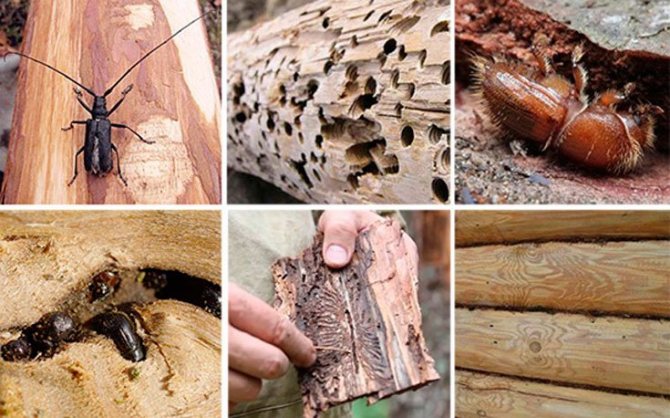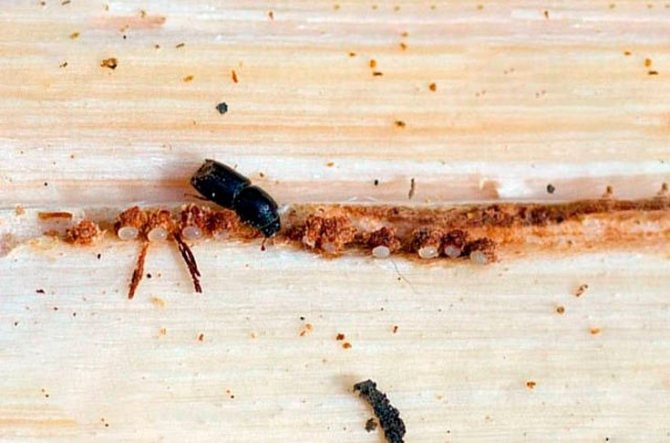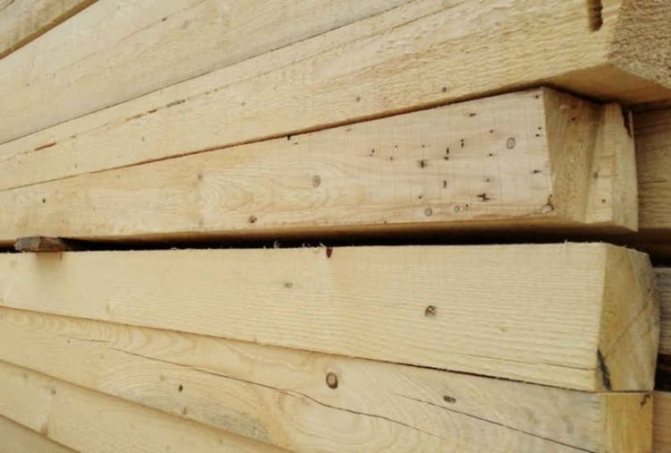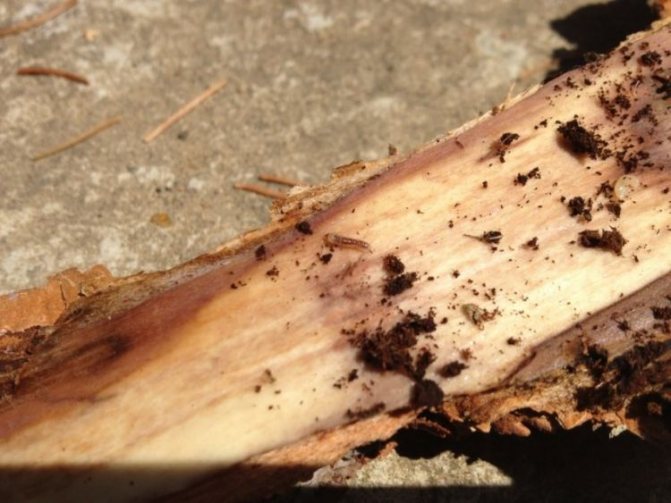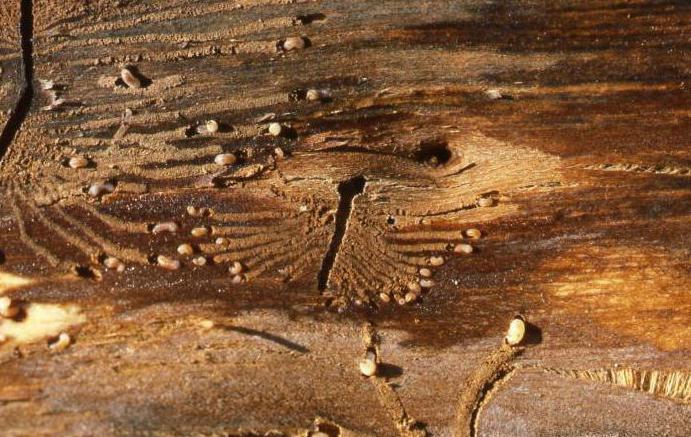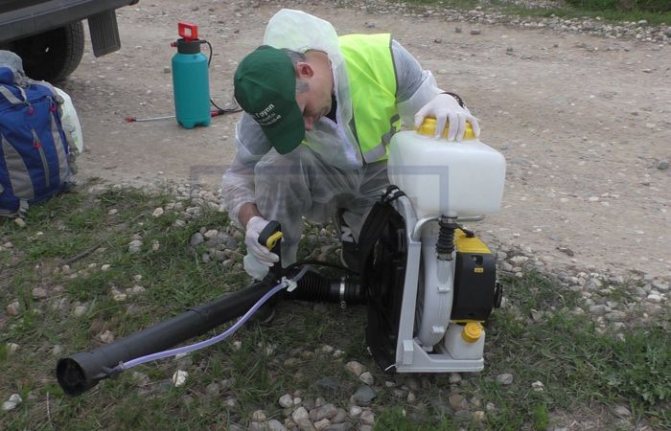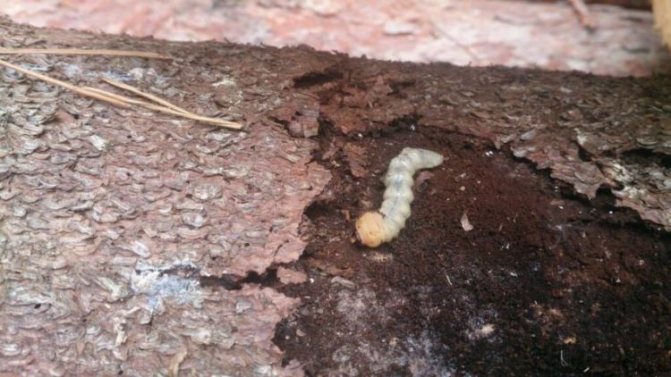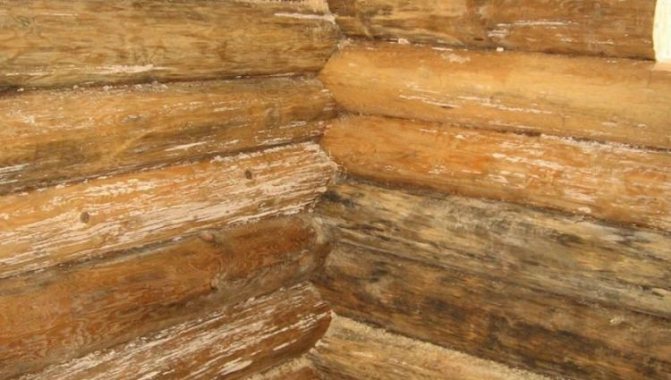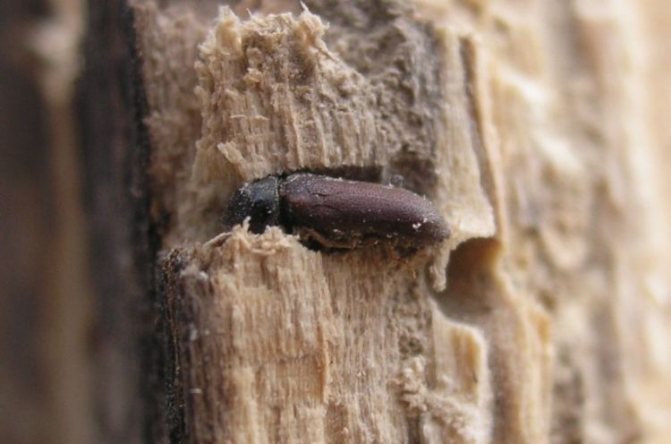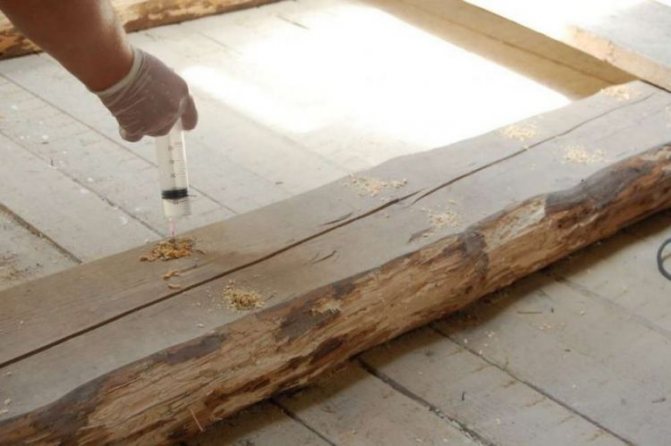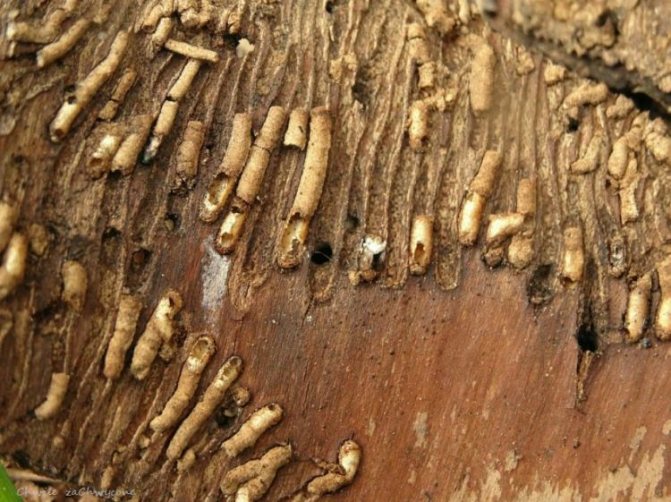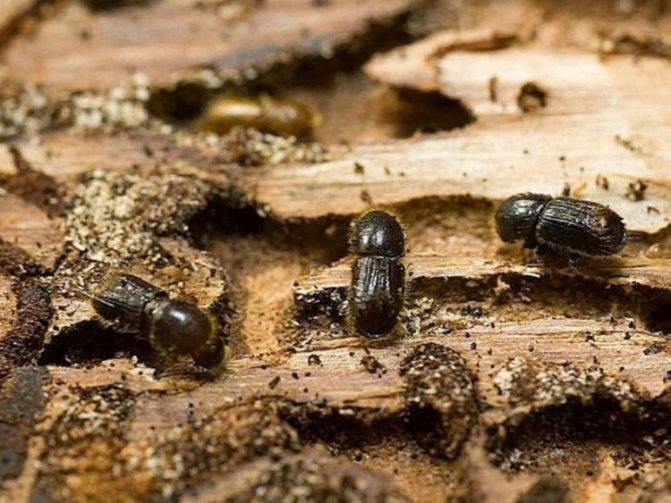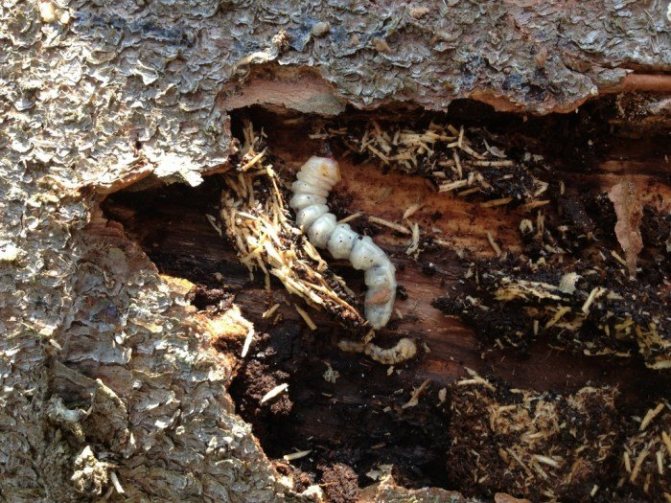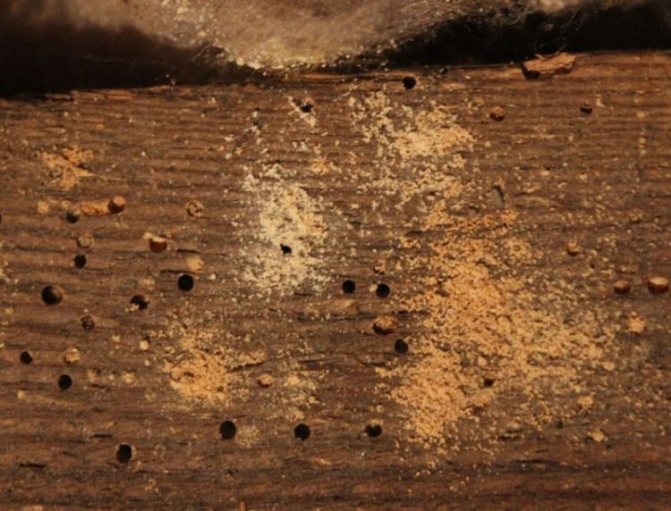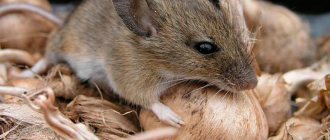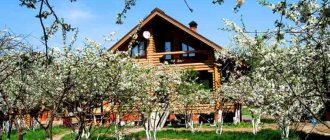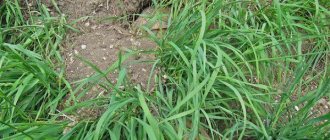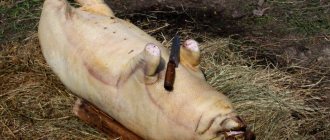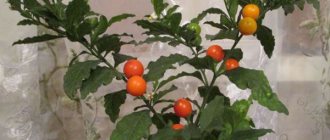Bark beetles can settle both in growing, still living, trees, and in a wooden house. The main difficulty in the fight against a beetle is its inaccessibility, since the parasite is located inside the wood for almost its entire life at all stages of development, where a person cannot physically reach. However, the problem of bark beetles is not uncommon, so there are several approaches to solving it. Each of them has a different efficiency and has its own specifics. Fighting bark beetle in a wooden house
can be done in three ways:
- Folk remedies
- Self insecticide and impregnation
- With the help of SES
Each of them will be discussed in more detail below.
How to protect the house from the bark beetle and what to do if it was not possible to avoid infection
Harm from bark beetles

Bark beetles do not pose any danger to people, as mosquitoes, flies, bugs or lice. The living environment of these insects is trees and all materials from them. Grinders hide in the bark of a tree, and gnawing through all its layers get to the center. There, the females lay eggs, which become larvae in a week and cause irreparable damage to the wood.
In 24 hours of the bottom, the larva is able to absorb about 10 g of wood.
In winter, the larvae fall asleep, they can withstand air temperatures up to -30 o C. It is interesting that they can stay in this mode for three years. Then they develop into pupae and adult beetles. And, the breeding process goes on as usual.


Adult bark beetles are able to move to neighboring trees, expanding the boundaries of their existence. Wooden structures become victims of woodworms: houses, sheds, baths. Wooden houses damaged by bark beetles are destroyed over time, the wood turns into dust. It is unsafe to damage the supporting structures, because in this case, the house may collapse. Woodworms have another negative property, they are carriers of fungal spores that accompany the formation of mold, and in fact it is very harmful to humans.
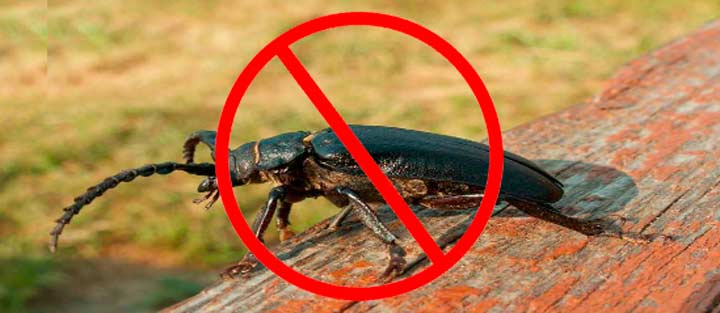

Very often, bark beetles start in wood stored in warehouses. Therefore, cases when contaminated material is used in the construction of houses are not alone. To avoid this, it is necessary to adhere to the standards of wood storage.
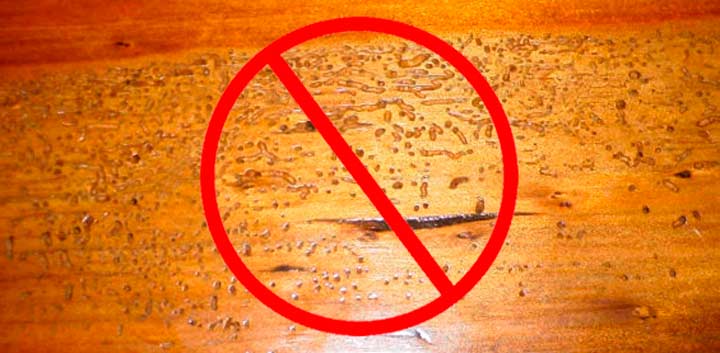

Before purchasing wood building materials, conduct a thorough inspection. Small holes and winding paths in the material should alert you. This is the result of the work of bark beetles. Unfortunately, untreated logs are difficult to inspect as defects are not visible on the bark.
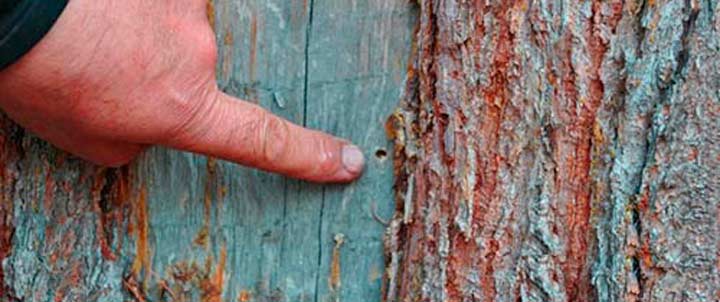

Therefore, experts recommend examining the cuts of the logs for damage.
The wood must be dry, since bark beetles feed on tree sap, the more of it in the material, the higher the chance of infection by insects.
When purchasing a house made of wood, first of all inspect it for traces of the vital activity of bark beetles. It is very likely that the owners are selling their homes precisely because of this.
To protect housing from this plague, be sure to treat wooden houses from bark beetles with antiseptic substances 2-3 times, with a frequency of 7 to 10 days. For this purpose, use: Antizhuk, Wood Doctor, Ecolan-41, etc.Premises that are not intended for human habitation are most often treated with recycled engine oil.
How to recognize a bark beetle
These insects are nocturnal, hiding inside the solid wood. In this regard, it is difficult to notice it, but it is possible if you pay attention to such nuances: carefully inspect wooden floors, walls, furniture, etc. Small holes of 1 - 2 mm indicate that there is an infection. Gnawing through the passages, bark beetles leave white or yellow dust. It can be found near baseboards and on the floor.
Night is exactly the time of day when you can hear how the bark beetle "crunches" wood. These sounds are reminiscent of a clock.
In ancient times, the sound of bark beetles grinding a tree was taken for a bad omen. It was believed that some of the inhabitants of the house would die. Nowadays, no one believes in superstition, but there is a rationally grain in this sign. After all, damaged wooden structures can collapse at any moment, which is fraught with death. In certain countries, the sound that the bark beetles make is still called the "clock of death".
Reproduction
With the arrival of spring, when the air temperature reaches + 10 ° C, the beetles begin to leave their wintering grounds. The males are the first to come to the surface, in search of a suitable tree for future offspring. The male penetrates under the bark of a tree and builds a rather spacious breeding burrow there. When everything is ready, the beetle begins to emit a special smell - a pheromone, to summon females. From 2 to 4 females fly to the smell.
After mating, the female goes to oviposition, making her uterine passage in the bark with a length of 8 to 16 cm and a width of 2-3 mm. On the way, she makes a side depression and lays an egg in it. Seals the entrance with sawdust and continues to work. In total, the female is able to lay, on average, up to 80 eggs.
The life cycle of the bark beetle includes 4 stages of development:
- egg - up to 2 weeks;
- larva - up to 3 weeks;
- pupa - a little more than 10 days;
- an adult.
From the moment of egg formation to the appearance of a young beetle, it takes about 60 days. It so happens that the female has not yet finished laying the uterine passage, and the laid eggs are already moving into the larval stage.
Larva
Having been born, the larva begins to gnaw through its individual path, directed strictly at an angle of 90 0 to the maternal path. The fleshy body of the larva is light, with a yellowish tinge and a brownish head, it has a concavity towards the ventral side. On it, a large number of callus-like checkers are noticeable, with the help of which the larva moves, gnawing its own course.
At this stage of development, the beetle causes the most harm, because the larvae actively devour the bast and de-energize the tree, destroying that part of it, along which the juices move. The larval passages end in a cradle, in which the insect turns into a pupa.
Chrysalis
In appearance, the pupa resembles a beetle. She has no cocoon, her body is short, compressed, light in color and soft. The pupal stage lasts up to 2 weeks. If she did not manage to turn into a young beetle before the onset of cold weather, then it remains to winter under the bark of a tree until next summer.
The young beetle does not immediately come to the surface. It remains under the bark for additional nutrition. One or two generations of young bark beetles may appear over the summer.


The newly-born pest remains overwintering near the tree, breaking through a hole in the ground to a depth of 10 cm within a radius of 3 m. The larvae and pupae remaining under the bark can live at temperatures not lower than -17 ° C.
Chemicals against bark beetle
Plant health is of great importance. The bark beetle does not like strong, resistant to habitat conditions, trees with strong immunity. Vitalizer HB-101 can help in this.
A growth stimulator based on natural substances not only increases yields, but also helps plants to fight pests with their own immune mechanisms. In addition, according to some reports, the drug paralyzes the insect's nervous system.
Of the funds directly intended to combat the bark beetle, the following can be noted:
- Clipper. A universal means of combating many types of pests, including the bark beetle;
- Woody healer. Biologically active substances of the drug will protect wood not only from bark beetle, but also relieve the appearance of fungal colonies, microorganisms;
- SENEZH INSA. An effective preparation for the destruction of insects. Non-toxic to pets and humans;
- Antizhuk. A popular drug that also has an antiseptic effect, however, just like SENEZH INSA. Supplied as a concentrate, which is diluted 1: 4. One package is sufficient for treating 100 m2 of wood.
Note! The listed preparations are non-toxic, recommended by experts for self-application. On the packaging of each product there is detailed instructions for use. Accurate adherence to the recommendations will be the key to success in pest control.
Preparing for fumigation
- Close off all parts of the room where gas should not enter (chimney, ventilation).
- Cover the frames of the wooden windows with masking tape.
- Sometimes the bark beetle settles not only inside, but also outside the house. In this case, the house needs to be wrapped with polyethylene, creating an airtight "dome".
- At the time of the procedure, equipment, personal belongings, plants, animals are taken out of the house.
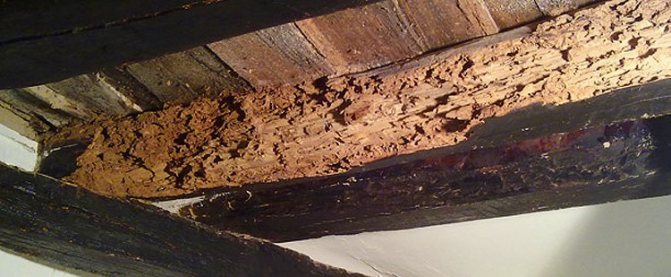

Application of a special solution for pest control
How else to remove a bark beetle larva? An equally effective way is the use of a special solution. This procedure requires preliminary preparation in the form of removing the affected areas of the tree.
The next step is to prepare the solution. For this purpose, rosin is added to the melted paraffin. The resulting mixture must be brought to a boil, then add vegetable oil and leave on low heat for another 10 minutes. Many experts recommend adding a fungicide to such a solution.
The cooled and infused mixture must be applied to the affected areas of the tree.
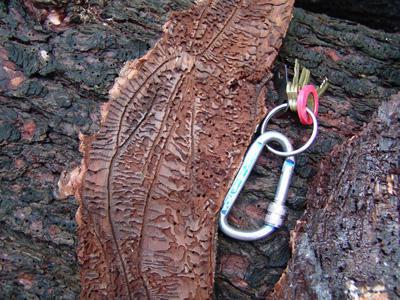

Release form
"Confidor" is presented on sale in the form of a transparent liquid (emulsion) and in the form of a brownish-coffee-colored powder.
Form of release of a liquid preparation:
- plastic bottles of 0.5 liters;
- 1 liter plastic bottles;
- blisters - 6 ampoules of 1.3 ml;
- blisters - 6 ampoules of 2 ml.
Advice
For small farms or for the treatment of indoor plants and orchids, disposable sachets (granules) or a preparation in ampoules (emulsion) are very practical. It is convenient to breed them and, for example, having processed a small pots with petunias from the ubiquitous aphids, you do not need to worry about subsequent storage, because we must not forget that an insecticide is a poison, although it is not dangerous for the nervous system of warm-blooded animals.
Powder form (water-soluble granules) is also available in several versions:
- sachet bag 1 g;
- sachet package 5 g;
- plastic bottles of 400 g.
Signs of tree infestation
It is possible to detect wood infected with insects by the appearance of small holes and small dust, reminiscent of flour, in it. To verify the presence of a beetle, you can pierce the bark of a tree or the surface of the wood with a sharp knife next to the groove you find. If at the same time emptiness is felt, then the plant or lumber is definitely affected by the pest.
In addition, its presence can be recognized by a special sound. Light crackles or creaks are often heard from wood infested with larvae.
Although the bark beetle looks quite harmless, the fight against the pest should be started as early as possible.If this insect appears in the garden, it means that it will soon switch to timber buildings, since these parasites multiply very quickly.
Testimonials
Having studied a large number of reviews about Confidor from summer residents, florists, we can conclude that the insecticide is very popular. Plant breeders appreciate the ease and ease of use for processing, note the positive effect after application within a few days, as well as the possibility of complex use and combination with other drugs.
Often, to get a good harvest, you cannot do without the use of chemicals, protecting plants from diseases and pests. And it is worth choosing such drugs that will be effective, reliable and as safe as possible for a person.
The confidor has rightfully earned the love of summer residents and gardeners, providing reliable protection of their plots and gardens.
Description and types of insect
Bark beetles are small beetles of dark brown or black color with a characteristic bevel at the end of the body. This bevel, bordered by teeth, is necessary for the insect to remove wood waste.
Insects of this family live, feed and breed exclusively in the tree. Most of them prefer conifers, living in spruces, firs, pines or cedars, however, there are also a lot of bark beetles who like to feast on deciduous plantations.


It is noteworthy that an adult beetle does not do much harm to trees, because the greatest danger to gardens and timber buildings is the larvae. The female beetle gnaws small holes under the bark, and then lays eggs in them.
When larvae with an insatiable appetite emerge from them, they expand their passages, paving whole mazes. The larval stage in a bark beetle can last for several years, so these insects can cause irreparable damage.
In each of the corridors gnawed by the bark beetle, you can find an expanded chamber where the larva pupates, and after emerging from the pupa, gnaws a hole outward and flies out of the tree. For a year, beetles are capable of giving 1-2 generations.
For the sake of fairness, it is worth mentioning that for all their habits that are destructive for plantings, bark beetles are considered the orderlies of the forest. These insects often select trees that are in very poor condition and destroy them, facilitating the replacement of old and diseased plants with healthy and young ones.
In the subfamily of bark beetles, there are more than 3 thousand species. Of these, over 200 species are found in Russia, spending most of their lives under the bark of trees. The most common are the following varieties:
- Typographer - this type of woodworm has a body 5-6 mm long. Its peculiarity is considered to be the hairs of a light brown shade, which grow on a black body with a shiny surface. The insect prefers to live in thick-baked coniferous trees. In addition, it can grow in fresh stumps and young trees.
- A furniture grinder is a small bug with a reddish-brown or brown body. Its body is distinguished by an elongated shape with a convex head, which is hidden in a kind of hood. Larvae of this species are most often found in houses, affecting window frames, furniture or floor coverings.
- The bark beetle is a common species of bark beetle that lives in taiga conditions. The beetle has an elongated hairy body. Its shade can be brown, black or brown, and depends on where the parasite lives. You can distinguish this species by the mustache, which resembles a mace. The bark beetle is able to fly over short distances, which is why it can quickly populate new territories.
- The large black barbel is a large pest with a body up to 3.5 cm in length, painted black with a greenish tint. As the name implies, the beetle has a long mustache that is more than twice the size of its body.On the tips of the elytra of the woodworm grows a clearly visible downy white. This species feeds on oak or conifers, preferring young shoots or fallen trees.
- Sapwood - has an oblong body, beveled at the back. Prefers elm trees and oaks.
Interestingly, experts can distinguish between the types of bark beetles by the patterns they leave in the wood. This is due to the fact that each of the varieties has a certain structure of moves, which together form a recognizable pattern.
Thematic Video:
Earlier, close attention was not paid to bark beetles, they did not pose a particular danger to trees. They chose only really sick trees, which did not have long to stay in the forest. But in recent years, their attacks have become massive on trees that can be walked out and brought back to life. It is not easy to cure such infected trees, they are mainly taken out of the forest and burned. In addition to trees in the forest, even houses and various buildings erected of wood are exposed to the invasion of bark beetles.
Signs of infection
Bark beetle footprints
Traces of the presence of the bark beetle and its larvae can be detected by the following signs:
- The appearance in the tree of small holes and the so-called wood flour;
- Light crackling.
In the first option, the probability of saving a wooden house from a pest still exists, in the second, the fight against the bark beetle may already be in vain.
On a note!
Having found small holes or bark beetles in the bark of a tree, you need to make sure that it is not damaged. To do this, pierce the bark next to the hole with a sharp knife. The presence of a void is a sure sign of a tree pest infestation.
Preventive actions
- It is necessary to cut off dry or diseased tree branches annually, because these beetles feel weak and strive for just such plants.
- It is necessary to paint the trunks in a timely manner with a lime solution.
- To combat the larvae, you can use a coating with phosphorus and organic preparations, this should be done during the period of insect activity.
- For better assimilation of chemicals, you can add grated laundry soap to them. Treat every 2-3 weeks.
- You can also use homemade "traps": before the season, freshly cut tree trunks are laid out along the edges of the site, the beetles will most likely choose them for reproduction, after which these trees are burned without waiting for the hatching of young bark beetles.
- Attracting birds or insects, which will gladly feast on a whole colony of parasites, is also an excellent option for prevention.


The reasons for the appearance and how to recognize it
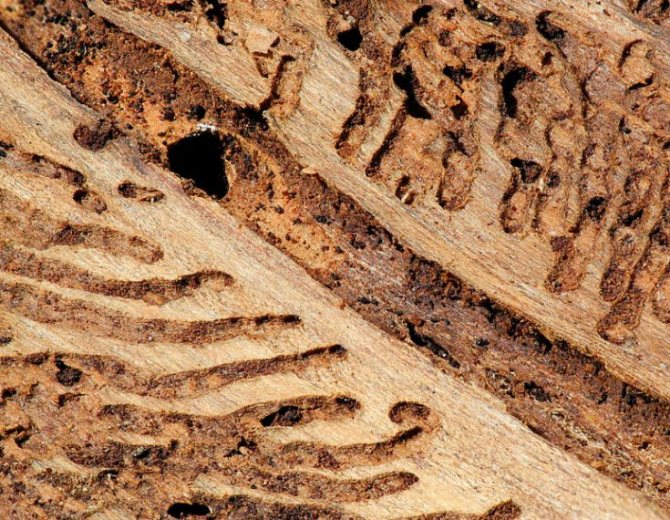

When builders build houses from wood, the wood is treated with special substances that prevent the appearance of the bark beetle. If you do not perform this operation qualitatively, then later, after a while, the beetle will definitely start to spoil the building made of wood. In addition, a bark beetle can appear in the house due to the use of low-quality raw materials for construction, already infected with a pest.
In the garden, there is a much higher probability of the appearance of a beetle, as these insects constantly migrate in search of new territories rich in green spaces. When they destroy one tree, they start looking for another.
To determine if a bark beetle has appeared in the garden, it is enough to carefully examine the trees. If not large holes are visible on the bark, and when you tap on it, you feel emptiness, then this is evidence that the tree is infected with a bark beetle. In such cases, you should immediately begin to fight this pest, otherwise it will soon take up wooden buildings.
Interesting to know! You can determine the presence of a bark beetle in the garden by the fine yellow dust that falls from under the bark of trees.This dust is a consequence of the vital activity of the parasite.
Prevention measures
Timely measures taken to prevent the appearance of the bark beetle will help protect the tree from pest infestation.
There are many such actions, and they depend on whether you need to do this in a forest plantation or in a house:
- Cracks, wounds, holes in the bark are closed with garden pitch.
- Coat the tree trunk with a mixture of humus and clay, thereby creating a barrier for beetles.
- Damaged leaves are burned and the trunk circle is deeply dug in.
- They take care of the trees according to all the rules so that the plantings are healthy and strong.
- An annual preventive treatment of trees with chemicals or a mixture of manure and slaked lime is carried out.
- Wood material intended for building a house or making furniture is carefully dried, ventilated, impregnated with a special compound against bark beetles.
Preventive measures against the attack of bark beetles are a necessary concern for protecting the environment and improving human living conditions.
Ways and methods of struggle
The bark beetle often populates abandoned buildings. If a wooden house has been neglected for a long time, without the necessary supervision, it is highly likely that its walls have long been eaten away by larvae. It is almost impossible to save such wood. The chances of a favorable outcome are increased if the pest is detected quickly. There are the following ways to deal with woodcutter beetle:
- mechanical;
- biological;
- chemical.
Country house owners can try to save the house from insects on their own. If the attempt is unsuccessful, you should seek professional help. High-quality disinfection from bark beetles in a wooden house will help to seriously and permanently eliminate the problem.
Development stages of the typographer beetle
How to get rid of mealybugs on houseplants
Analyzing the photographs, it becomes clear that this type of beetle goes through three stages in its development.
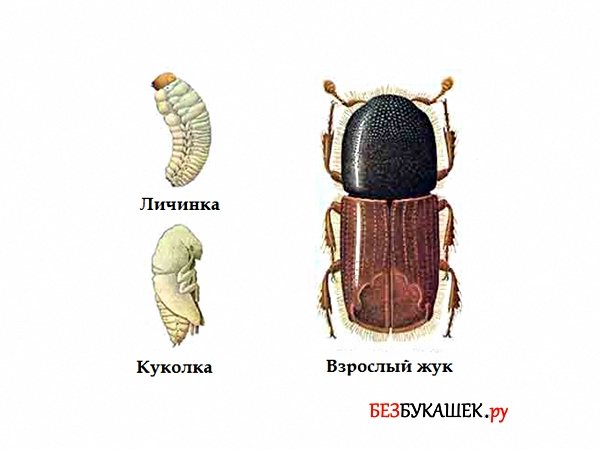

Three stages of development of the typographer beetle
Consider each:
- Larva stage. The bark beetle larva is large, has a white or slightly yellowish color. It is always slightly curved towards the abdomen; strong bulges are observed on the body, resembling tiny pads, or calluses. The larva needs them as support when it moves inside a narrow passage in the wood. The head of the larva is small, strong, brownish in color, and the body is covered with microscopic hairs. It can live inside a damaged tree from several months to a year, depending on environmental conditions.
- The pupa stage. Gradually developing, the larva turns into a pupa, which already has underdeveloped wings and legs. The head is much better developed than that of the pupa; antennae even protrude from it, reaching up to the front thighs.
- The stage of an adult beetle (imago). A sexually mature typographer has a rounded, dense brownish body with an average length of about five millimeters. In the second photo, it can be seen that its wings at the back have a characteristic depression, which allows the insect to rake off the wood dust that occurs when the beetle moves inside a narrow passage. Adult typographers fly very rarely, only during mating or in order to change their habitat if food runs out in the previous one.

